Introduction
Gender equality is considered a keystone for prosperous and modern economies, according to the Organization for Economic Cooperation and Development (OECD). In 2010, the OECD created the Gender Initiative to promote gender equality in education, employment, and entrepreneurship among its members. This initiative aims to reduce the under-representation of women in STEM (Science, Technology, Engineering, and Mathematics), which is evident in member countries, where only 18% of new engineering students are women (OECD, 2017). This institution acknowledges the need for policies and initiatives to encourage young women to pursue STEM careers, as well as initiatives to build confidence in their mathematical skills. Colombia became a member in 2018, so it is necessary to align its policies with OECD standards. However, in order to propose new policies, it is necessary to be aware of the real situation of women in STEM programs in Colombia. To this end, this paper presents an analysis based on the statistics of the Labor
Observatory for Education (OLE) and the National Information System for Higher Education (SNIES) regarding women who have graduated from engineering programs between 2001 and 2018.
Previous works have shown the gap in engineering degree programs in Colombia. Quintero (2016) presented a study about the exclusion of women at Universidad Nacional de Colombia. This study highlighted that the largest public university of Colombia had only 37% of women students in 2017, women's participation in STEM careers was under 30% during that year, and the rate of absorption of men duplicates that of women. Similar gaps were identified in math programs in Colombia (Gonzalez-Gutierrez, Sepulveda-Delgado, and Espejo-Lozado, 2018). However, this is a worldwide reality (García-Holgado et al., 2020); women hold only 26% of jobs in technology companies, and this percentage is as low as 28,8% in science. In Latin America, statistics are alarming; for example, in 2015, only 17% of engineering researchers were women in El Salvador, 17% in Honduras, 30% in Costa Rica, 39% in Paraguay, 40% in Venezuela, 31% in Uruguay, 19% in Chile, 25% in Colombia, 19% in Panama, and 25% in Bolivia (Arredondo et al., 2019). Several studies described the gender gap in STEM programs around the world. In the U.S, there is one woman for every four men enrolled in physics, engineering, and computer science degrees (Cimpian, Kim, and McDermott, 2020). In France, the number of women in STEM programs in higher education is only 30% (Breda, Grenet, Monnet, and Van Effenterre, 2020). Finland has a 12,39% of women students in STEM programs (García-Holgado et al., 2020). In contrast, countries such as Spain have similar enrollment indexes to South America, with 33% of women in STEM programs (García-Holgado et al., 2020). In countries such as the U.S., the gender gap is accentuated in the workplace, where women earn less than men in STEM-related occupations (Sterling et al., 2020).
There are proposals to reduce the gender gap in STEM. For instance, the joint effort between educational institutions, the industry, and the government to create national policies oriented towards supporting women in STEM areas shows promising results (García-Holgado et al., 2020). The exposure of girls at an early age to role models encourages selecting STEM careers and is recognized as an essential step to reduce the gender gap (Breda et al., 2020). However, there is still a long way to go in this regard, considering the gender gaps between teachers and researchers in the STEM areas (Rodríguez-Rodríguez, Rodríguez, Ramallo-González, and Elizondo-Moreno, 2020). It should be noted that women's performance in STEM areas is no longer considered a factor in the existing gender gap. Previous studies showed that women in these areas could perform equally or better than men (Rodríguez-Rodríguez et al., 2020), and that women with higher performance at the schools are the ones who select STEM as a career path (Cimpian et al., 2020).
In this paper, analysis of the gender gap in engineering programs in Colombia for three levels: undergraduate, master, and Ph.D., as well as an analysis according to regions, specific fields of engineering, and salary. This analysis is based on statistical data from the OLE and SNIES between 2001 and 2018. Finally, we review international programs and initiatives to reduce the gender gap in engineering programs, highlighting possible solutions to reduce it in our country.
Analysis of gender gap
The data were obtained from the National Information System for Higher Education (SNIES, 2019) and the Labor Observatory for Education (OLE, 2019), both from the information system of the Colombian Ministry of Education. The data of graduates is available for the period between 2001 and 2018, and the salary information is available until 2016. In this paper, the variables used for the analysis are: (1) number of graduates from undergraduate programs according to gender and graduation year, (2) number of graduates from master's and Ph.D. programs according to gender and graduation year, (3) number of graduates according their regional jurisdictions and graduation year, (4) programs with higher preference according to gender, and (5) salary according to gender. The following sections present each variable and its respective analysis.
Analysis according to degree level
We analyzed the rate of women and men graduates from engineering programs at three levels: undergraduate, master, and Ph.D. We included only the five-year undergraduate or so-called 'professional' programs from public and private higher education institutions. Programs were obtained from 81 universities, 2 professional technical institutes, 6 technological institutes, and 64 universities and related institutions. Table 1 presents the percentages of men and women between 2001-2018 for the different levels. Figure 1 compares the number of women and men graduates from engineering undergraduate programs between 2001-2018 in Colombia. It is clear in this Figure that the ratio between women and men had no substantial changes during these years. The graduates from engineering programs were 63,4% men and 36,6% women in 2001. Likewise, 63,7% of graduates were men, and 36,3% were women in 2018. Figure 2 presents the number of graduates according to gender for master's degree programs. A more significant number of men also graduated from such programs than women. The percentages match those observed for undergraduate programs: for 2001, 30,0% of graduates were women, and, in 2018, this percentage was 32,3%. Figure 3 presents the data for graduates from Ph.D. programs. In this case, we can see a significant increase in women graduates while comparing 2001 and 2018, due to the fact that, in the former, the country's first doctorates were still being consolidated. In this year, 100% of Ph.D. graduates were men. It was only until 2004 that the first women graduated from doctoral programs. As of 2018, the rate of Ph.D. women graduates was 27,5%.
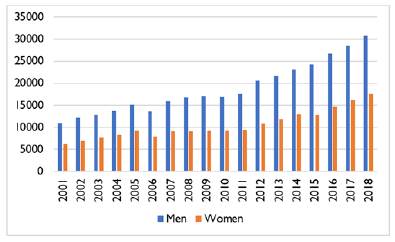
Source: SNIES (2019)
Figure 1 Men vs. women graduates from undergraduate engineering degree program between 2001 and 2018 in Colombia.
Table 1 Percentages of women and men graduates from engineering degree programs between 2001 and 2018 in Colombia
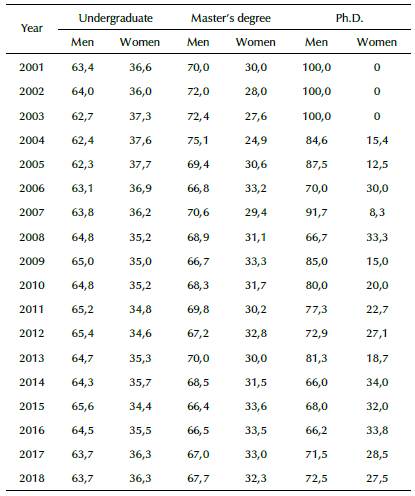
Source: SNIES (2019)
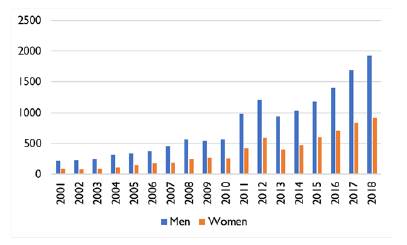
Source: SNIES (2019)
Figure 2 Men vs. women graduates from master's programs in engineering between 2001 and 2018 in Colombia.
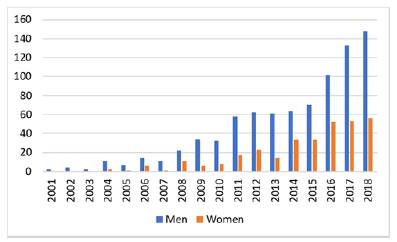
Source: SNIES (2019)
Figure 3 Men vs. women graduates from Ph.D. programs in engineering between 2001 and 2018 in Colombia.
Several countries present similar percentages of women enrolled in engineering programs. For example, women amounted to 31% of the undergraduate and graduate student population in Chile's technological programs (Gándara and Silva, 2016). In the U.S., women account for 38% of the bachelor's degree in 2018 (Charlesworth and Banaji, 2019). Several studies have sought to establish why this gap in STEM still exists. The most frequent reasons are associated with socio-cultural factors (Charlesworth and Banaji, 2019; Barone and Assirelli, 2020). For example, studies have shown that women find it more difficult to obtain opportunities or to be successful in STEM-related areas. In addition, stereotypes that associate science and mathematics more with men than with women are also highlighted. Furthermore, other studies have found that women do not choose STEM careers because there are not enough mentors or role models to generate an interest in these fields during their early years (Botella, Rueda, Lopez-Inesta, and Marzal, 2019).
Analysis according to region
In addition to the degree-level analysis, we analyzed the graduation rates of men and women from undergraduate programs according to region. For this, we considered data regarding graduates from engineering programs in Antioquia, Atlântico, Bogotá D.C., Caldas, Santander, and Valle del Cauca. These regions were selected because they have the greatest number of students and higher education institutions. Figure 4 presents the rate of women graduates from undergraduate engineering programs in the selected regions. Women's representation in undergraduate engineering programs ranges from 29% to 45%, depending on the region and the year. For Bogotá D.C., women represented 31% to 35% of graduates between 2001 and 2018, which is similar to the national rate. Atlántico, Caldas, and Valle del Cauca presented a decreasing number of women who earned an engineering degree. In 2005, 41% of engineering graduates were women in Atlântico. However, in 2018, this percentage decreased to 33%.
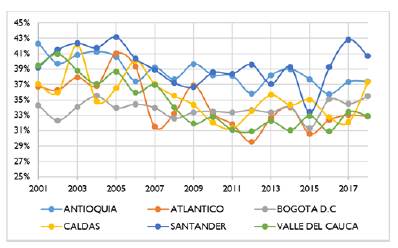
Source: SNIES (2019)
Figure 4 Rate of women graduates from undergraduate programs in engineering between 2001 and 2018 in Antioquia, Atlántico, Bogotá D.C., Caldas, Santander, and Valle del Cauca.
Similarly, 42% of graduates in Caldas were women in 2003, but there were only 37% in 2018. In Valle del Cauca, the rate of women graduates reached its peak in 2002 with 41%, and women's representation decreased to 33% for 2018. As seen in Figure 4, Santander and Antioquia reported better percentages of women graduates from engineering degree programs. In Santander, 43% of graduates were women in 2005 and 2017, and 41% in 2018. Although the representation of women engineering graduates declined between 2001 and 2018, it remained above 37% in Antioquia during this period.
Analysis according to field of engineering
In Colombia, engineering programs are categorized into fourteen areas that encompass the different denominations of undergraduate and postgraduate programs according to the field of study. Using the data from SNIES (2019), we studied the gender gap according to these areas, which is shown in Figure 5. Most women who graduated from engineering programs in Colombia obtained a degree related to industrial engineering (30%). Careers related to systems engineering and telematics graduated 18% of women in the country. 11 percent of women graduated from environmental or sanitary engineering, and 10% from civil engineering graduated. Programs related to agro-industrial and food engineering, electronics and telecommunications engineering, management engineering, and chemical engineering graduated 5% of women each between 2001 and 2018. The lowest proportions of women who earned an engineering degree in Colombia graduated from programs such as agronomy and livestock engineering (2%), mines-metallurgy and mechanical engineering (2%), agricultural and forestry engineering (2%), electrical engineering (1%), and biomedical engineering (1%). Figure 6 presents the proportion of women vs. that of men in each field of knowledge. More women than men graduated from programs like management, environmental, sanitary, biomedical, agro-industrial, food, and chemical engineering programs. A similar number of women and men graduated from programs such as industrial, agricultural, and forestry engineering. However, the gender gap increases in programs like agronomy, livestock, mines, metallurgy, system, telematics, and civil engineering, where the rate of women graduates ranges between 30% and 38%. The worst gender gap is seen in programs related to electronics, telecommunications, electrical, and mechanic engineering where women represent only between 10% and 18% of graduates. These preference by some engineering fields was studied in the literature (Cheryan, Ziegler, Montoya, and Jiang, 2017; Blosser, 2017). Cheryan et al. (2017) describes three reasons for the lower representation of women in computer science and engineering compared to biology and agricultural science: masculine culture, insufficient early experience, and gender gaps in self-efficacy. On the other hand, Blosser (2017) argues that engineering programs related with industry and biology required communication and social skills that attract more women than men. Instead, mechanical, electrical, and electronic engineering are fields were men dominate the workplace, thus decreasing the interest of women students. Similar to the overall gap of women in engineering, the selection of a specific field is related to sociocultural factors and stereotypes.
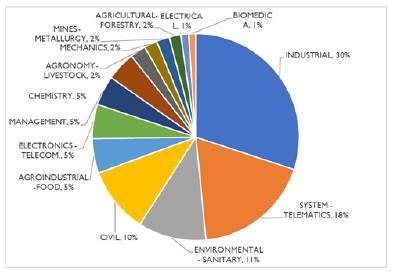
Source: OLE (2019)
Figure 5 Percentage of women graduated from undergraduate programs in engineering between 2001 and 2018 according to field of engineering.
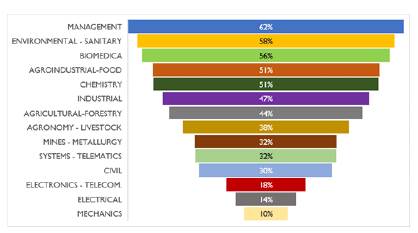
Source: OLE (2019)
Figure 6 Rate of women vs. men graduates from undergraduate programs in engineering between 2001 and 2018 according to field of engineering.
Analysis of salary according to gender
Another variable studied in this paper is the salary of engineering graduates according to gender. The data was obtained from OLE and was only available from 2007 to 2016. For the comparison, we computed the percentages that represent the difference between the salaries obtained by both women and men. Table 2 presents these percentages, where rows represent the year of graduation, and columns the analyzed years. According to OLE data, there are wage differences between men and women. The average wage gap between men and women between 2007 and 2016 is 15%. These percentage is lower than in other countries. For instance, women in the US earn 21% less than men in STEM careers (Charlesworth and Banaji, 2019). From the table, we can see that the difference in salarybetween men and women has been decreasing. For example, a woman who graduated in 2001 received 19% less salary than a man in 2007, and 20% less salary in 2016. However, a woman graduated in 2016 had an entry salary 13% lower than a man. This may indicate an improvement in the wage gap at the beginning of the work life, but there is still a need for strategies to address the issue.
Table 2. Gap between salaries for male and female graduated engineering
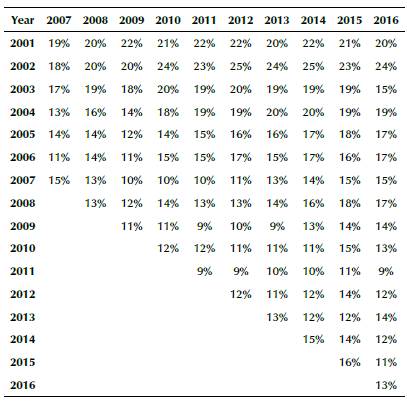
Note: Note: Rows correspond to the graduation year.
Source: OLE (2019)
Review of initiative to reduce the gender gap in engineering
The low representation of women in engineering programs is not a phenomenon exclusive to Colombia. At an international level, different initiatives and programs can be found that promote this career path for women. In several studies, the lack of awareness about gender bias at different levels is highlighted. Women, teachers, and mentors often ignore this gap (Charlesworth and Banaji, 2019). In addition, there are several socio-cultural factors that influence the selection of careers among women. The perception that STEM environments are for men (Charlesworth and Banaji, 2019), and that women do not have the same intellectual capacity as men (although studies have shown that thisdifference does not exist), are stereotypes that maintain the gender gap in engineering.
Studies suggested that the interest in engineering emerges during the early years (Charlesworth and Banaji, 2019). Therefore, an early orientation in high school can increase the interest in specific fields (Barone and Assirelli, 2020). This approach was applied in several initiatives oriented towards encouraging women to pursue STEM careers through the promotion of engineering programs. Examples of these initiatives are the University of Granada's Technological Campus for Girls, Women TechMaker, Tech & Ladies, IGNITE (Inspiring Girls Now In Technology Evolution), and Engineer Your Life, which are events for girls in their last years of school (Paderewski-Rodriguez et al., 2017). Other initiatives are oriented to develop STEM skills in the early years. For example, Girls Who Code (www.girlswhocode.org) promotes computer science careers in girls through after-school clubs to teach coding, summer immersion in tech jobs, and the creation of communities with other women in college campus. Similarly, Techbridge Girls (www.techbridgegirls.com) promotes all STEM fields in girls through after-school activities.
Other programs are oriented towards improving the performance of women in STEM, based on early mentorship by a faculty researcher. For instance, the AEMES (Achieving Excellence in Mathematics, Engineering, and Science) program of the Smith College in the US (Katz et al., 2017) focuses on the recruitment and permanence of under-represented minorities and first-generation college students. Katz et al. (2017) reported that women AEMES students achieved a higher GPA (grade point average) and increased their participation in natural science research.
An interesting case of women enrolled in engineering programs is presented by the United Arab Emirates and Qatar, with 44,5% and 44% of women's representation in engineering programs in 2017, respectively (Ainane, Bouabid, and El Sokkary, 2019). The study presented by Ainane, et al. (2019) showed that the main motivations for the increasing interest of women in engineering programs are related with the ideal to serve their community and make their families proud.
Conclusions
The gender gap in engineering and in all STEM areas is a worldwide problem. Colombia is not alien to this phenomenon, which is a consequence of several socio-cultural factors and stereotypes. This article presents the current state of this gap in engineering programs in the country at three levels (undergraduate, master's and doctoral), based on the official numbers of the National Ministry of Education.
The obtained results are alarming. Only 36% of students who graduated from undergraduate engineering programs were women in 2018. The percentages of women graduating from master's and doctoral programs are very similar. However, what is most alarming is that this percentage has not changed significantly since 2001. This indicates a lack of awareness about the gender gap, as well as a lack of public policies that promote the training of women in engineering in the country. Similar gaps are found at the regional level, but they are wider in some areas such as Bogotá D.C. and Valle del Cauca.
It is also clear that the gender gap in engineering also depends on the field of knowledge. Women represent more than 50% of students in programs such as administrative, environmental, biomedical, chemical, agro-industrial, food, and industrial engineering. However, the gap is drastically increased in careers such as mechanics, electricity, electronics, and telecommunications, where women are less than 20%. This is especially critical when considering the country's policies aimed at promoting 4.0 Industries, where these careers very important.
At a global level and in previous studies, we can find indications to improve this reality. On one hand, it is necessary to implement programs that promote engineering in the early school years, increasing the interest in areas like robotics and programming, as well as educating to eliminate cultural stereotypes. On the other hand, it is necessary to develop mentoring programs that allow girls and teenagers to meet women engineers, thus creating communities that allow women to be the roles to follow. Finally, there is a need for programs that finance female students in engineering careers at all levels.
We must acknowledge that Colombia is far from closing the gender gap. First, it is necessary to recognize that there is a bias, and that all social actors (e.g., schools, universities, teachers, ministry) must propose programs and initiatives to address this issue.
Finally, it is necessary to highlight some of the limitations of this study. The results and analysis presented in this article are limited to the statistical data available in the Ministry of Education databases. To propose programs and strategies to close gaps in Colombia, it is necessary to study the causes and factors that influence the selection of careers for women in the country. Regarding the identification of successful international programs, the analysis can be extended with a systematic review of programs in other countries, which will allow the identification of lessons learned to support the design of a strategy for our country.















